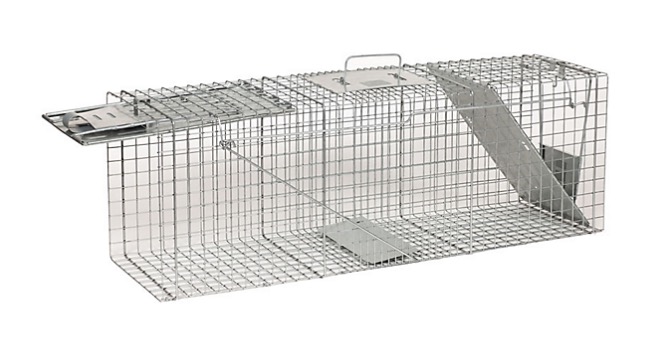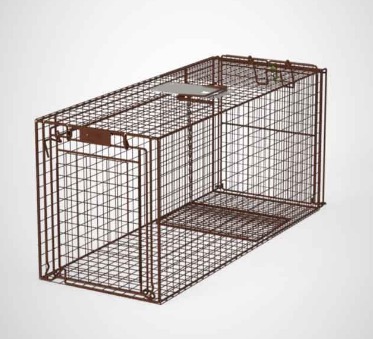Finding a live trap to catch a cat, whether domesticated or (semi-)feral/stray cat is not hard. Finding a humane one is a lot harder. Finding a humane one in time to try to catch a very pregnant cat is almost impossible. Especially in Covid times... We had to resort to a borrowed trap, because our preferred one (see bottom of this article) arrived way too late.
Most everything is limited to online ordering, which means you are flying blind. There are many different types of traps. We have the opportunity to use one that was particularly mild, but still with an effective tripping system. It was property of the first local rescue group we contacted, once we had decided to try and trap Mitsy. Unfortunately the trapping was not successful and we returned the trap to the rescue group, once we noticed that Mitsy suddenly was a lot of slimmer, meaning that she had delivered her litter. Trapping her now would have been a death-warrant for the newborns.
A few months later, when we realised she was pregnant once more, we ordered a Havahart humane trap online. It looked good on the video materials I had researched online. I saw it used in mass-trappings in cities like New York and it seemed effective without hurting the animals.
But when it arrived on our door step and I started to practice with it, I was aghast. This trap has 2 doors, which is what we wanted, and it was sturdy enough to keep a wild animal in. It was, in fact, so sturdy that I started to doubt that we wanted to use. It was a metal contraption, the edges were rough and unfinished and before I knew it, I was covered in scratches on my arms, legs and hands. I developed an intense dislike of the thing and decided to try and find an alternative.

What’s to dislike about the Havahart?
The trap shown in the above picture is totally functional. However, it is a metal construction with unfininished edges that I scratched my skin on when I was only just trying to find out how to work with it. Once I tried out the mechanism, I also found that the trigger doors slam shut with a lot of power. It seems overkill for the cat we wanted to trap. However, there are many varieties of this model that you may find perfectly fine. Maybe I am just too squittish 🙂
What is good about this model is that it has 2 doors. The advantage being that, when your catch has to stay in the trap for a few hours, you can use one door for food and the other for refuge.
Another good thing is the protective place where the handle is.
Not so good: this trap does not include a divider: a type of fork that you can use to safely move your catch from on end to the other.
Also not so good: as I mentioned the trigger mechanism is super fast and powerful. If you choose to use this model, make sure that the length of the animal you are after does not make it partially hang out of the trap as it is with its feet on the trip plate. It is said that most animals hear the trap mechanism go off before it actually locks them in and will gather their legs under their body to prepare to jump out, but I am not certain that there is no risk of getting hit by the door as it is coming down. Make your own choice and let it be a calculated one.
I asked to borrow or rent the trap we used the first time, when we were unable to trap Mitsy (because she did not come by when the trap was activated). But that rescue group gave us the cold shoulder when they found out we wanted to try and do the care taking ourselves. They told us we were too inexperienced and too unaware of the risks involved (also see the chapter on feral/stray project elsewhere on this website). They also did not want to be liable if anything were to go wrong with the use of their traps. It really upset us, I will not lie. Since we met with them the first time, we had spent days and months to get better informed. We did a TNR course with Toronto Community Cats to get certified and we talked to and emailed with a lot of people who had more experience than us. We explored the internet and watched every video we could get our hands on. In short, we did our utmost to become aware of everything involved in not just trapping, but being involved in the follow-up as well. In order to become more experienced, we figured, living the experience would be the best way to go. And we were wise enough not to try and do this alone. We had built a network of people to help, from rescue groups to volunteers, vets and adoption centers for the kittens.
I contacted another rescue group and got lucky: they thought they might have a trap for me to borrow. It was ‘brandless’ and said to have been purchased from Canadian Tire a long time ago. I felt a lot better about this trap: the metal was smoothly finished, the trigger system was mild. Good enough to trap a small cat like ‘our’ cat. So we used that one. We also donated the Havahart we purchased. Many people use it for mass cat trappings; it is not a bad trap. It was just not the one we preferred.
So now we had a trap. Now we had to think about a contained space that we could use as a temporary shelter for a mom with whatever number of kittens she would bring to our world…
Post script: the trap we preferred has finally arrived!
Our Tru Catch Fat Cat Trap arrived mid August. Almost 2 months after we ordered it… It is the ‘nicest’ trap for cats that I have personally seen… The main difference between this model and any of the others I have seen, is that the trap is triggered mechanically, without a spring-powered system. It may be the type of trap that some animals manage to escape from, but the look and feel of this product just agrees with me better. If you catch something you did not set out to catch, you can flip the cage and open the back door easily to let your unwanted catch escape. It is a good idea to fasten this door with a carabiner to make sure it does not open if the cat inside flips the cage while thrashing around to get out.
When your catch steps on the trigger plate, the door-closing system is activated and the door then is locked in place via two rings that come down. The trap comes to just CAD 100 and includes a separator: a metal ‘fork’ that can be used to move the cat from one side of the trap to the other. It is nicely finished and you can even choose a colour, how is that for a luxury choice? 🙂 Read what else I found out about traps in the section ‘Feral/Stray Cat Project’ on this website.

Possibly the only comment I have about this product is that the dividers that come with it cannot be fixed into place. When inserted from the side or the top, they can sort of swing back and forth. They would not keep a panicked cat in place, I think. Or maybe I am misunderstanding. We have not had to use them for Mitsy.
Post script 2: Using a drop trap
Below is a video that shows how to use a drop-trap, sometimes also referred to as a ‘gravity trap’. I have no personal experience with it, but I like how this video shows all the ins and outs to prepare for a trapping.
Check to see if your local stores offer this cage for sale. Here is a link to a website where you can purchase it:
https://www.livetrap.com/index.php?dispatch=products.view&product_id=30250